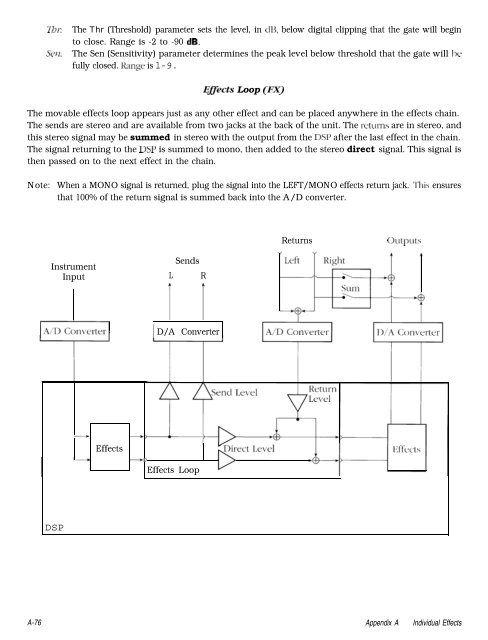Contents - Peavey.com
Contents - Peavey.com Contents - Peavey.com
71~ The Thr (Threshold) parameter sets the level, in dH, below digital clipping that the gate will beginto close. Range is -2 to -90 dB.SUZ: The Sen (Sensitivity) parameter determines the peak level below threshold that the gate will befully closed. Kange is l-9.Eflects Loop (I;x)The movable effects loop appears just as any other effect and can be placed anywhere in the effects chain.The sends are stereo and are available from two jacks at the back of the unit. The returns are in stereo, andthis stereo signal may be summed in stereo with the output from the DSP after the last effect in the chain.The signal returning to the DSP is summed to mono, then added to the stereo direct signal. This signal isthen passed on to the next effect in the chain.Note:When a MONO signal is returned, plug the signal into the LEFT/MONO effects return jack. This ensuresthat 100% of the return signal is summed back into the A/D converter.ReturnsOutpLltsInstrumentInputlil) ISendsL RI ID/A Converter+ +Effects->Effects LoopDSPA-76 Appendix A Individual Effects
ParametersSend: The Send (Send Level) parameter determines the level of the signal that is sent to the Effects Sendjacks. Range is O-100.Dir: The Dir (Direct Level) parameter determines the level of the direct signal that is mixed with theinput from the effect loop returns. Range is O-100.Rtn: The Rtn (Return Level) parameter determines the level of the signal that is returned to the effectschain. Range is O-100.Sum: The Sum (Summed Return Level) parameter turns ON and OFF an analog switch that sums thestereo returns with the analog output from the digital effects.Splitter/B&Amp (SP)The splitter/hi-amp effect enables you to split the stereo signal into two separate chains, placing different effecttypes on each chain. The signal following the splitter is MONO and only appears on one channel. Therefore,note that the signal on the LEFT path (top line) only passes through the LEFT half of effects following thesplitter, and the signal on the RIGHT path (bottom line) only appears on the RIGHT channel of effectsfollowing the splitter.High Pass Filter>>EffectsBalanceEffectsbLeft OutEffects *Right Out1 Low Pass Filter I ISplitter/&-AmpParametersA&x&There are two modes available; SPLITTER and BI-AMP.Bal: The Bal (Balance) parameter controls the righ #‘left balance of the splitter output. This works likea normal stereo balance where the signal output from both sides is 100% at a balance of 50; at0, 100% of the right signal is passed through and none of the left signal is passed; at 100, 100%of the left signal passes and none of the right signal is passed.Hi-L; This is a high pass filter that allows frequencies higher than the specified frequency to pass to theleft channel. Range is 20 Hz to 3.3 kHz. This parameter is not available when SPLITTER is used.Lo-R: This is a low pass filter that allows frequencies lower than the specified frequency to pass to theright channel. Range is 20 Hz to 3.3 kHz. This parameter is not available when SPLITTER is used.Appendix A Individual Effects A-17
- Page 2 and 3: AIntended to alert the user to the
- Page 4 and 5: Quick StartIn an effort to make usi
- Page 6 and 7: Introduction(obligatory Opening9Con
- Page 8 and 9: Chapter 1SetupTU6EFEX’”TUBE GUI
- Page 10 and 11: COAHVECTION DIAGRAMSThere are many
- Page 12 and 13: 3. Using a separate preamp, distort
- Page 14 and 15: 5. Direct connection to a mixing co
- Page 16 and 17: Chapter 2OverviewGETTING STARTEDAft
- Page 18 and 19: CHROMATIC TUNERThe Tube Fex comes w
- Page 20 and 21: PERFORMANCE PARAMETER CONTROLMost e
- Page 22 and 23: The format of the IMIDI lxmk select
- Page 24 and 25: To dump a set of presets to an exte
- Page 26 and 27: Chapter 5 RAM CartridgeThe optional
- Page 28 and 29: Program Mapping‘TWX the night bef
- Page 30 and 31: 10. Press the right arrow button on
- Page 32 and 33: 3. Position the cursor under DP; us
- Page 34 and 35: Clean, Crunch, Lead parameters (Pas
- Page 36 and 37: Compressor ccn)The Compressor effec
- Page 38 and 39: The versatile Chorus effect allows
- Page 40 and 41: This delay creates a stereo delay f
- Page 42 and 43: Pitch 1 and Pitch 2 (PI and P2)In o
- Page 44 and 45: Clussic EQ (CQ)The Classic Equalize
- Page 46 and 47: Envelope Filter (EF)The Envelope Fi
- Page 50 and 51: Appendix B MIDI ImplementationModel
- Page 52 and 53: Levels:Reverb:Overdrive:Chorus:Dela
- Page 54 and 55: Effects can be added to the current
- Page 56 and 57: FX-TYPE 9:Classic EQPRAM0 = Low Gai
- Page 58 and 59: FX-TYFE $13: Stereo SimdutorPRAM0 =
- Page 60 and 61: SpecificationsFrequency Response12H
- Page 62: IMPORTANT SAFETY INSTRUCTIONSSAVE T
71~ The Thr (Threshold) parameter sets the level, in dH, below digital clipping that the gate will beginto close. Range is -2 to -90 dB.SUZ: The Sen (Sensitivity) parameter determines the peak level below threshold that the gate will befully closed. Kange is l-9.Eflects Loop (I;x)The movable effects loop appears just as any other effect and can be placed anywhere in the effects chain.The sends are stereo and are available from two jacks at the back of the unit. The returns are in stereo, andthis stereo signal may be summed in stereo with the output from the DSP after the last effect in the chain.The signal returning to the DSP is summed to mono, then added to the stereo direct signal. This signal isthen passed on to the next effect in the chain.Note:When a MONO signal is returned, plug the signal into the LEFT/MONO effects return jack. This ensuresthat 100% of the return signal is summed back into the A/D converter.ReturnsOutpLltsInstrumentInputlil) ISendsL RI ID/A Converter+ +Effects->Effects LoopDSPA-76 Appendix A Individual Effects



